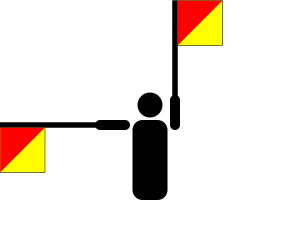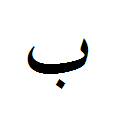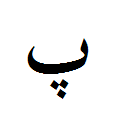P
P or p (pronounced: [ pʰeː ]) is the 15th letter of the classical and the 16th letter of the modern Latin alphabet . It's a consonant . The letter P has an average frequency of 0.79% in German texts. This makes it the 21st most common letter in German texts .
pronunciation
p is a hard stop and also stands for the voiceless bilabial plosive in the International Phonetic Alphabet (IPA) . At the end of the word, in the standard pronunciation of b, final hardening occurs - Examples: rubbed [ˈʁiːp]; Sieve [ziːp]; stayed [bliːp]. The corresponding fortis is the P. Together with an h it is pronounced as “ph” like an f .
When spelling and in abbreviations it is spoken together with an “e” as “pe” or - in echoes of the Greek alphabet and for a clear acoustic differentiation from the letter “b” - with an “i” as “pi”. In the spelling alphabet it says "Paula" or "Petra", or in the international spelling alphabet ( ICAO , NATO and USA) "Papa".
In the Saxon dialect there is no distinction between soft and hard letters, so the P is pronounced as B. Example: Babba for "Papa", gabudd for "kaputt". In a stressed position, however , the P is pronounced more in standard German than in an unstressed position.
origin

|

|

|

|
|

|
| Throwing stick (protosinaitic) | Phoenician Pe | Early Greek pi | Classical Greek Pi | Etruscan P | Latin P |
The early form of the letter P in Protosinaitic script is possibly the symbol for a throwing stick . However, this exit symbol is only partially accepted in the literature; some sources do not give an exit symbol. What is certain is that there is a letter in the Phoenician alphabet called Pe (mouth), which is similar to the throwing stick of the Protosinaitic script and has the shape of a loop open to the left. The phonetic value of the Pe among the Phoenicians was [p].
The Greeks took over the letter with this sound value and gave it the name Pi . At the beginning, the Pi was still similar to the Pe, but became increasingly geometrical as the writing tools were changed. The originally different length vertical lines of the pi were brought to the same length until the classical Greek alphabet. In addition to aesthetic reasons, this could also have been caused by the possibility of confusion with the gamma .
The early Greek form of the pi was adopted into the Etruscan alphabet. Unlike the Greeks, the approach was not lengthened, but rounded off. The Etruscan form of the P was adopted in the Latin alphabet, but it was mirrored when the writing direction changed from right-to-left to left-to-right. As a further modification, the rounded part was connected to the letter approach.
p in statistical tables
According to DIN 55301 (design of statistical tables), the minuscule p ( English p for p reliminary ), which is placed after a value (number) in a table compartment, stands for "preliminary number" as a value-supplementing character, also quality indicators (in contrast to value-substituting characters). This is exactly how the symbol is used in tables of official statistics .
Other notations
 The letter P is in the finger alphabet
The letter P is in the finger alphabet Letter P in shorthand ( German unitary shorthand )
Letter P in shorthand ( German unitary shorthand ) The letter P in the Cyrillic alphabet is almost no different from the Greek pi
The letter P in the Cyrillic alphabet is almost no different from the Greek pi Morse code for the letter P.
Morse code for the letter P. The letter P in the flag alphabet
The letter P in the flag alphabet P in winker alphabet
P in winker alphabet On the keyboard (typewriter, PC) the P is at the top right. It is operated in the ten-finger system with the right little finger.
On the keyboard (typewriter, PC) the P is at the top right. It is operated in the ten-finger system with the right little finger. In the automotive distinguishing signs the letter is P for Portugal
In the automotive distinguishing signs the letter is P for Portugal
The finger alphabet for the deaf or hard of hearing represents the letter P with the palm facing down, the index finger pointing forward and the middle finger and thumb forming a circle. The remaining fingers are on the palm.
This flag P in the flag alphabet (also known as Blue Peter ) is set to indicate that a ship is about to leave the port within the next 24 hours. It is a sign for the crew on shore leave to come aboard and that local suppliers should present outstanding invoices. At sea, on the other hand , the P flag means : "My nets have got stuck in an obstacle".
The Arabic alphabet has no letters for P . There is the B ( Bā ' ) on the loud P . For example, Baris (باريس) is written and spoken in Arabic instead of Paris . Instead of Panama it is called Banama (بنما), instead of Peru it is called Biru (بيرو), instead of Pakistan it is called Bakistan (باكستان) and for Papa it is called Baba (بَابَا). The Persian alphabet uses the Arabic alphabet in a completely modified form. The Persian letter for P ( Pe (Persian letter) ) is a slightly modified Arabic P : instead of one point it has three points.
In the knock code , the P is transmitted by "3.5".
Quote
"P the german writers hark the plaser, even has a little underschaid of b, one is taken for the other." "[...] the b and p is made with the life, torn open by the force of the breath that one holds the breath mouths with closed mouth, which he pushes open in his cheeks like a whistler, and then lets the breath faren through open life; the p is herter. ”Quotes from the Grimm dictionary
See also
Web links
- http://www.wam.umd.edu/~rfradkin/sin2phoen-animate.html
- http://www.ancientscripts.com/protosinaitic.html
Individual evidence
- ↑ Guidelines for the design of statistical tables for network programming, Working Group Publications of the State Statistical Offices, Wiesbaden 1997, 41 pages, here: page 36.
- ↑ GENESIS-Online database: Explanation of symbols
- ^ Aventinus : Johannes Turmair's, called Aventinus, Bavarian Chronicle, edited by Matthias Lexer. Munich, 1882. First volume. First half (book I.) cap. 1, pp. 30, 14
- ↑ Valentin Ickelsamer : A Teütsche Grammatica. Printed in: Heinrich Fechner (Hrsg.): Four rare writings of the sixteenth century. Georg Olms Verlag, 1972





